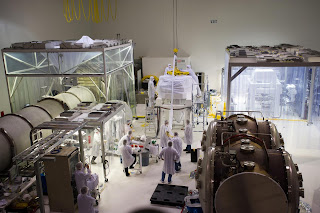 |
| Installing one of Advanced LIGO's seismic isolation platforms at the Hanford observatory in 2013. |
ENGINEERING RUNS
These test runs are called engineering runs. We abbreviate them ER followed by the number of the run. The last one was called ER8. I've already talked about the first one (ER1) back when almost everything was being simulated since the installation of the instruments was just getting off the ground. The purpose of those early engineering runs was to test out the ability of our data analysis systems to handle the large amount of data we will collect. As parts of aLIGO were installed, we replaced the simulated data from that component with real data. ER8 was our first test of all of the instrument without anything being simulated. While the purpose of this data is to test the stability of the whole system and to find other small bugs, we are still running all of our data analysis methods over the collected data. We don't expect to find a gravitational wave in this data, but if we have compelling reason to believe that we really did see something we will certainly pursue it as a real detection. Don't get too excited, though, since there are no indications that we collected a gravitational wave.
OBSERVING RUNS
What is really exciting is that we are preparing to make that first detection. We don't really expect to detect a gravitational wave with our first science data (which will be called O1 - observation 1) with aLIGO but it is not as improbable as it was with Initial LIGO. We are talking about what we learned from the blind injection in our last iLIGO data set (otherwise known as the "Big Dog" event) and what our detection validation should entail. We are talking about writing the paper that we will publish announcing the first detection and its details. We are even talking about how we will engage the public with this announcement. Don't misunderstand me - we have not seen anything yet, but we are preparing ourselves for the possibility of detection.
DETECTION IS POSSIBLE...
You really don't have any idea how exciting this is especially for those of us who have been around a while (I have been working on LIGO since starting grad school in 1999 and I'm a youngster). I have been working on this project that is so much bigger than myself since before we took our first data with Initial LIGO. I remember when the collaboration was a couple hundred scientists (there are now almost 1000 of us). I remember when we analyzed our first data and debated how to interpret our detection candidates when we almost sure that everything we had was noise (i.e. garbage). Now we are talking about confidently making a detection, and doing astronomy with it. This is the dawn of a new age in astronomy and I'm proud to be here to see it.
 |
| Distance in parsecs (1 pc = 3.26 light years) Initial LIGO
was able to detect its standard source of 2 neutron stars orbiting each
other just before they merge into one body. (Read more here.) aLIGO wil be able to "see" up to 200 Mpc (about 650 million light years). |

